The best water filter pitchers are affordable, portable, and reduce dozens of contaminants using gravity-fed water filtration.
We use our own evidence-based testing to review and compare water filters.
I’ve personally tested all the water filters on this list, leveraging my experience as a WQA Certified Water Specialist (CWS) and Certified Water Treatment Representative (CWR) to review each product as both an expert and a customer.
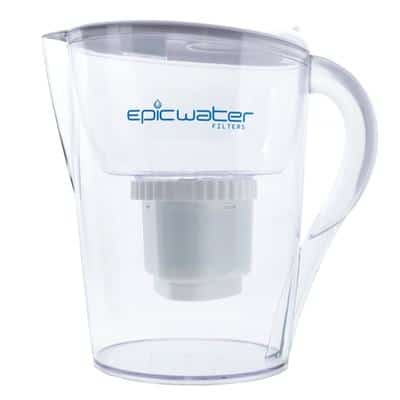
Epic Pure Pitcher
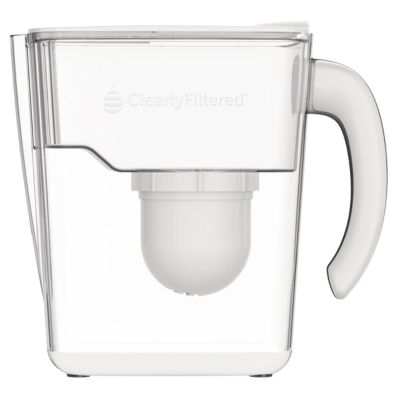
Clearly Filtered Water Pitcher
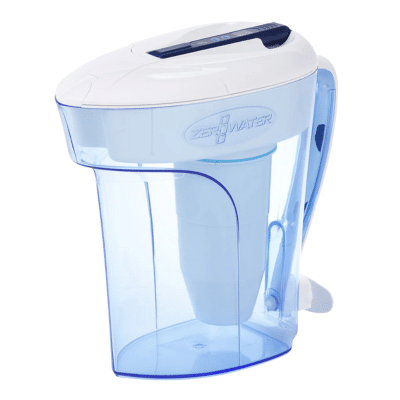
ZeroWater Ready-Pour Pitcher
Table of Contents
Our Testing & Selection Process
The 5 Best Water Filter Pitchers
| Product |  Epic Pure | 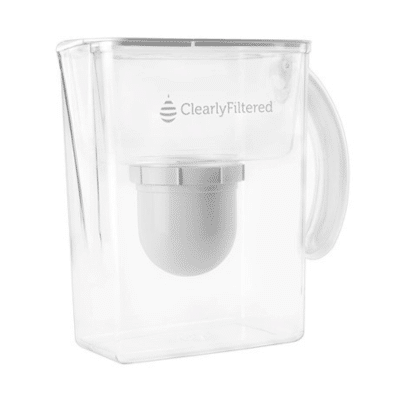 Clearly Filtered |  ZeroWater Ready-Pour r | 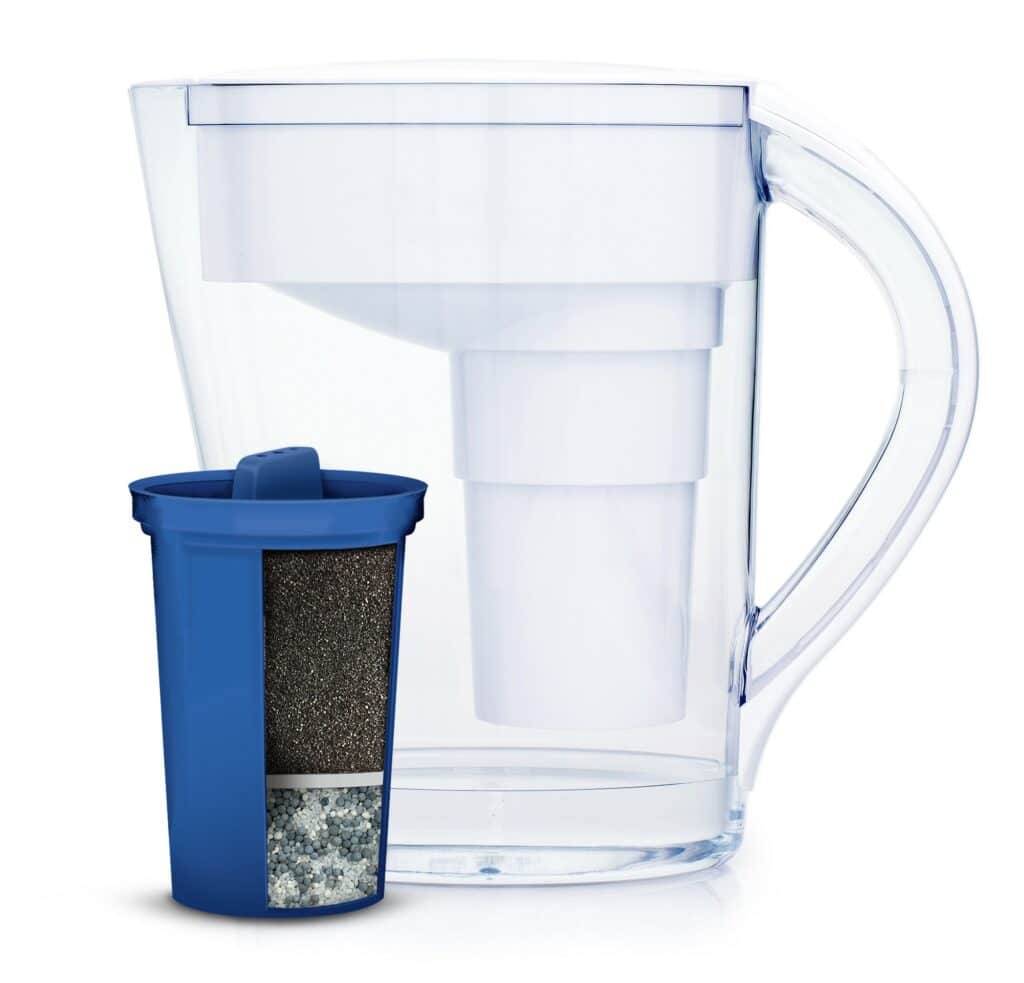 Santevia MINA | 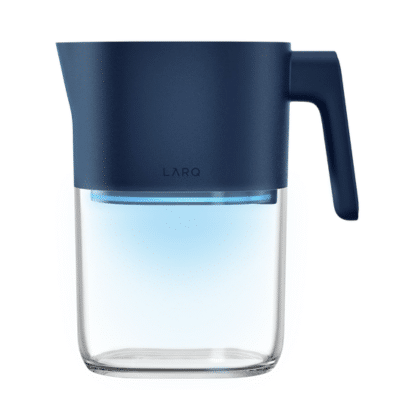 LARQ Pure-Vis Advanced |
|---|---|---|---|---|---|
| Score | 8.90 | 8.78 | 8.62 | 8.45 | 8.21 |
| Price | $70.00 | $90.00 | $39.99 | $49.99 | $139.00 |
| Certifications | Not certified | NSF/ANSI 42 & 53 | NSF/ANSI 42 & 53 | Not certified | Not certified |
| Filter Capacity | 150 gallons | 100 gallons | 25 gallons | 80 gallons | 60 gallons |
| Cost per Gallon | $0.31 | $0.55 | $0.70 | $0.25 | $0.54 |
| Warranty | Lifetime | 1 year | Vessels 90 days, filters 30 days | 90 days | 1 year |
| Read Review | Epic Pure review | Clearly Filtered review | ZeroWater review | Santevia MINA review | LARQ Pure-Vis Advanced review |
Epic Pure Pitcher

The Epic Pure Pitcher uses a solid carbon block filter that blends three activated carbon media to reduce dozens of common drinking water contaminants. It got the best contaminant score out of all the water filter pitchers we tested, and we were pleased with its quick and easy setup and maintenance processes.
Best For
Product Specs
| Price | $70.00 |
| Contaminants Reduced | 200+ |
| Certifications | Not certified |
| Process | Solid Activated Carbon Block |
| Filter Capacity | 150 gallons |
| Annual Cost | ~$150 |
| Warranty | Lifetime |
Why It’s Best
The Epic Pure Pitcher is the best overall water filter pitcher because it secured the best score for contaminant reduction.
In our testing, it reduced all health-related contaminants in our water to below the testing lab’s Health Guideline Levels (HGLs), and, unlike with some of the other pitchers we tested, no unwanted impurities appeared post-filtration.
Plus, it’s one of the best-value water filter pitchers we tested, costing less than $70 upfront and boasting a super affordable ongoing cost.
Epic Pure Performance
The Epic Pure scored a 9.30 for reducing health-related contaminants in our water. Our test results showed that the filter reduced 100% uranium, copper, and phosphorous, as well as 92% sulfate, 57% molybdenum, 41% barium, 27% fluoride, and 20% nitrate.
The system also reduced 100% chlorine in our water, so it scored a 9.90 for improving our water’s aesthetics.
Our only disappointment was that the filter isn’t performance certified, which reduced its score slightly.
The Epic Pure also impressed us with its setup and maintenance requirements – we awarded it a score of 9.50 for both categories. Setup was easy because the filter didn’t need priming; we just washed and assembled the pitcher and reservoir, then filtered and discarded the first two pitchers of water.
We calculated the pitcher’s ongoing maintenance cost as $0.31/ gallon, meaning that we’d spend half as much as some of the other top-performing pitchers we tested. Replacing the filter was easy, and the 150-gallon filter capacity is one of the best we’ve seen. The pitcher has an LED countdown timer that helped us to know when to buy new filters.
We think the Epic Pure is the best water filter pitcher for folks who want an all-rounder that can effectively reduce a range of contaminants, even though not all contaminants were completely eliminated. Anyone who wants a filter that’s affordable and easy to set up and maintain should also be pleased with the Epic Pure pitcher.
| Criteria | Results |
|---|---|
| Overall Score | 8.90 |
| Health Related Contaminants | 9.30 |
| Aesthetic Related Contaminants | 9.90 |
| Performance Certification | Not Certified |
| Filtration Rate | 2.23 GPH |
| Component Quality | Unsatisfactory |
| Component Certification | Not Certified |
| Setup | Outstanding |
| Servicing Requirements | Outstanding |
| Costs | $0.31/ gallon |
| Warranty Length | Lifetime |
| Shipping | Free shipping for the Clean Water Club only |
| Returns | Lifetime |
Clearly Filtered Pitcher

The Clearly Filtered Water Pitcher reduced more contaminants than most other water filter pitchers we’ve tested, and it has an advantage over the Epic Pure pitcher: a WQA performance certification for chlorine and PFOA/PFOS reduction.
Best For
Product Specs
| Price | $90.00 |
| Contaminants Reduced | 350+ |
| Certifications | NSF/ANSI 42 & 53 |
| Process | Coconut Carbon Block |
| Filter Capacity | 100 gallons |
| Annual Cost | ~$150 |
| Warranty | 1 year |
What We Thought
The Clearly Filtered Water Pitcher is the water filter pitcher that we recommend for folks who want a system with a great overall contaminant reduction performance.
It offered a greater contaminant reduction percentage than most similar systems in our testing, and we also noted that the pitcher materials felt sturdier and thicker than other pitchers, which felt flimsier and thinner in comparison.
Setup was also really easy for the Clearly Filtered pitcher. Rather than having to filter and discard several batches of water (which is time-consuming), we primed the filter using the included priming bag, which took less than 10 minutes.
Clearly Filtered Performance
We awarded the Clearly Filtered Pitcher a score of 8.24 for overall contaminant reduction. It did better than the Epic Pure at reducing 100% fluoride, and its 100% uranium, chlorine, and copper reduction matched Epic’s results.
The CF pitcher also reduced 86% barium, 67% strontium, and 53% molybdenum. But its score was affected by the presence of 0.0054 PPM of cobalt in our filtered water (it hadn’t been detected pre-filtration).
There were two standout performance features that gave Clearly Filtered the edge over Epic: its WQA performance certifications and its high-quality plastic design.
The pitcher has been certified (to NSF Standards 42 and 53) to reduce 3 out of the 365+ contaminants it’s claimed to reduce, so it’s not the most impressive proof of performance that we’ve seen, but it’s still more reassuring than nothing.
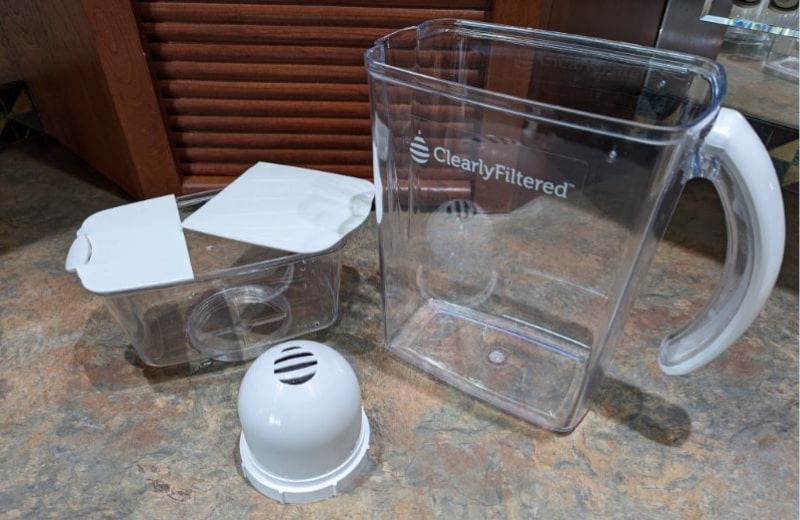
As for design, the Clearly Filtered pitcher got a score of 9.70. The pitcher is made from BPA-free Tritan plastic and is WQA certified for lead-free design, on top of holding a materials safety certification as a component of its performance certifications.
We timed the filtration process and recorded that the CF pitcher filtered 0.5 gallons of water in 13 minutes and 12 seconds, giving it a 2.27 GPH filtration rate. This put it slightly ahead of the Epic Pure, which had a 2.23 GPH filtration rate – but both filters got the top score here.
We think the Clearly Filtered Pitcher makes the most sense for people who are happy to pay a slightly higher upfront and ongoing cost to effectively address many contaminants in their water with a system that’s certified for performance and materials safety.
| Criteria | Results |
|---|---|
| Overall Score | 8.78 |
| Health Related Contaminants | 8.30 |
| Aesthetic Related Contaminants | 9.90 |
| Performance Certification | Certified for <1% of reduction claims |
| Filtration Rate | 2.27 GPH |
| Component Quality | Outstanding |
| Component Certification | Certified |
| Setup | Outstanding |
| Servicing Requirements | Outstanding |
| Costs | $0.55/ gallon |
| Warranty Length | 1 year |
| Shipping | Free shipping |
| Returns | 30 days |
ZeroWater Ready-Pour Pitcher

The ZeroWater Ready-Pour Pitcher offers a unique take on gravity-fed water filtration, using a 5-stage filter to reduce TDS down to 0. The unit is certified to reduce more contaminants than the CF pitcher and reduced the highest concentrations of many contaminants in our water, including fluoride, uranium, and nitrate.
Best For
Product Specs
| Price | $39.99 |
| Contaminants Reduced | 24 |
| Certifications | NSF/ANSI 42 & 53 |
| Process | Activated Carbon + Ion Exchange Resin |
| Filter Capacity | 25 gallons |
| Annual Cost | ~$110 |
| Warranty | Vessels 90 days, filters 30 days |
Our Verdict
The ZeroWater Pitcher is another system that impressed us with its thorough contaminant reduction. It also got great scores for its filtration rate and setup.
The pitcher has a handy way of tracking filter life with the included TDS meter. It’s designed to reduce TDS down to 0, and ZeroWater says that you should replace the filter when the TDS meter reads 006. This meant that we had more certainty on when to change the filters because we weren’t only relying on a timer or water volume tracker.
Plus, it’s certified to reduce 6 contaminants – that’s 3 more than Clearly Filtered.
ZeroWater Performance
ZeroWater received an 8.34 score for contaminant reduction. Our test data showed that it had reduced 100% fluoride, chlorine, uranium, barium, strontium, molybdenum, nitrate, and sulfate. It also reduced 97% copper – an excellent result overall.
But 3.4 PPB of chloroform (a disinfection byproduct) was detected in our filtered water, which wasn’t detected in our unfiltered water. This pulled down the filter’s contaminant reduction score. The filter also greatly reduced healthy minerals in our water as part of its TDS reduction, which we weren’t impressed with.
We were pleased to see that the ZeroWater Pitcher has NSF Standard 42 and Standard 53 certifications for reducing chlorine taste and odors, mercury, lead, PFOA, PFOS, and hexavalent chromium. But we still think it could be certified to reduce more contaminants – ZeroWater claims it can reduce 24.
We awarded the pitcher a 10.00 for filtration rate. We calculated that it filtered 0.391 gallons of water in just under 9 minutes, giving it a filtration speed of 2.62 GPH (making it slightly faster than Epic and Clearly Filtered).
Setup was easiest with the ZeroWater pitcher because it was the only pitcher that required no filter priming, soaking, or flushing. The filter arrived ready to go, so we could start using it straight away. It got the same high score (9.50) as Epic and Clearly Filtered in this category.
ZeroWater’s maintenance requirements let it down somewhat. It has the worst capacity of any water pitcher filter we’ve tested – just 40 gallons – with some customers claiming it only lasted 1-2 weeks. Plus, its ongoing cost of $0.70/ gallon was up to triple the cost per gallon of many other pitchers we tested.
We recommend the ZeroWater filter pitcher to anyone who wants a comprehensive water filtration solution that reduces high levels of many contaminants, at the expense of a short filter lifespan and higher ongoing cost.
| Criteria | Results |
|---|---|
| Overall Score | 8.62 |
| Health Related Contaminants | 8.30 |
| Aesthetic Related Contaminants | 9.90 |
| Performance Certification | Certified for 25% of reduction claims |
| Filtration Rate | 2.62 GPH |
| Component Quality | Fair |
| Component Certification | Certified |
| Setup | Outstanding |
| Servicing Requirements | Outstanding |
| Costs | $0.70/ gallon |
| Warranty Length | Vessels 90 days, filters 30 days |
| Shipping | Free shipping on orders above $60 to continental US |
| Returns | No returns |
Santevia MINA Pitcher

The Santevia MINA Pitcher is the only alkalizing water filter pitcher to make our list. It did a great job of reducing many contaminants in our water, and we were impressed with its ability to raise water pH by up to 2.0 (although our own results varied – more on that later).
Best For
Product Specs
| Price | $49.99 |
| Contaminants Reduced | 85 |
| Certifications | Not certified |
| Process | Carbon + Ion Exchange + Remineralization |
| Filter Capacity | 80 gallons |
| Annual Cost | ~$120 |
| Warranty | 90 days |
Why We Liked It
The Santevia MINA was the best alkalizing water filter pitcher we tested, being the only filter to reduce healthy contaminants and increase the pH and alkalinity of water.
It’s also the most affordable of all the pitchers we’ve mentioned in this guide so far, falling within the $0-$50 price bracket, and with an ongoing cost of just $0.25/ gallon – impressive given that it provides an additional water quality advantage that none of the other systems offer.
Santevia MINA Performance
The Santevia MINA pitcher’s overall contaminant reduction score was 8.12, putting it only slightly behind Clearly Filtered and ZeroWater. It reduced 7 contaminants in our water: 100% chlorine, uranium, molybdenum, and copper, 78% barium, 77% nitrate, and 72% strontium.
However, the MINA pitcher isn’t performance-certified, which affected its overall score in this category. Plus, fluoride actually increased slightly from 1.1 PPM to 1.2 PPM, telling us that the filter doesn’t effectively address this contaminant.
Santevia’s main selling point is its ability to increase the alkalinity of water, which has a few possible health benefits. When we first got the pitcher, we used a pH meter to test our water. The unfiltered water had a 7.89 pH, and our filtered water’s pH had increased to 9.94. However, when we tested the pitcher later with a lab test, pH only increased by 0.1, from 7.4 to 7.5.
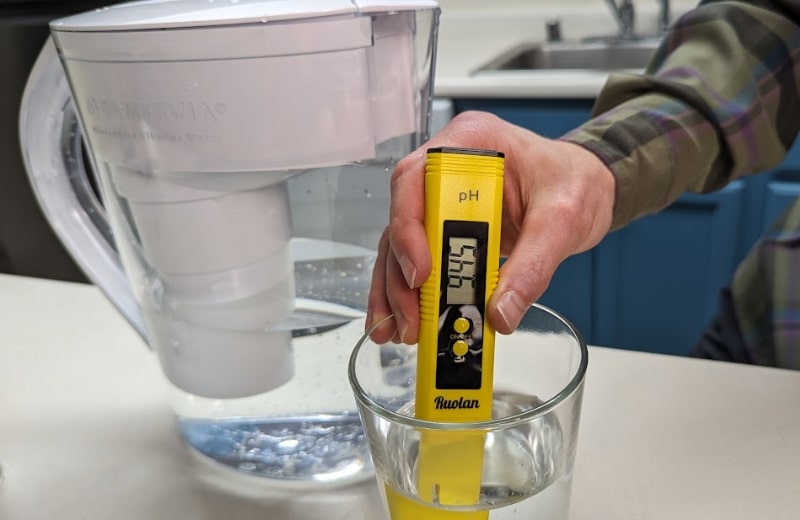
The system got an 8.50 score from us for its filtration rate. It filtered 0.383 gallons of water in just over 16 minutes, giving it a filtration rate of 1.43 GPH – around 1 GPM slower than most other pitchers we tested.
We couldn’t fault the filter setup process. It also got a 9.50 in this category because assembly took less than 5 minutes – we just had to wash and assemble the pitcher, then hold the filter under running water for 1 minute until the water ran clear.
We think the Santevia MINA pitcher is a great fit for folks who want to go a step further than simply reducing contaminants in their water, and anyone who wants the possible taste and health benefits of filtered water with an alkaline pH.
| Criteria | Results |
|---|---|
| Overall Score | 8.45 |
| Health Related Contaminants | 8.30 |
| Aesthetic Related Contaminants | 9.50 |
| Performance Certification | Not certified |
| Filtration Rate | 1.43 GPH |
| Component Quality | Outstanding |
| Component Certification | Not certified |
| Setup | Outstanding |
| Servicing Requirements | Outstanding |
| Costs | $0.25/ gallon |
| Warranty Length | 90 days |
| Shipping | Free shipping on orders over $99, except Hawaii, Puerto Rico & Alaska |
| Returns | 30 days |
LARQ Pure-Vis Advanced Pitcher

The LARQ Pure-Vis Advanced Pitcher filters and purifies water with a unique 2-stage process involving a filter cartridge and a UV wand. It reduced numerous contaminants in our testing, and we thought it had the most attractive design of all the water filter pitchers we tested.
Best For
Product Specs
| Price | $139.00 |
| Contaminants Reduced | 60+ |
| Certifications | Not Certified |
| Process | Activated Carbon + UV Purification |
| Filter Capacity | 60 gallons |
| Annual Cost | ~$150 |
| Warranty | 1 year |
Our Take
The LARQ Pure-Vis Advanced Pitcher is the most expensive water filter pitcher we’ve tried, but it’s the only pitcher with a unique UV purification stage to prevent bacterial growth in the filtered water chamber.
The pitcher’s filtration performance wasn’t far off Clearly Filtered’s – it got the same score in our lab testing, but it doesn’t have a performance certification.
LARQ Pure-Vis Performance
We awarded the LARQ Pure-Vis pitcher an 8.14 for contaminant reduction. It did a great job of removing 100% uranium, barium, strontium, and molybdenum, and reducing 97% copper, 88% sulfate, and 20% nitrate. Unfortunately, it didn’t reduce fluoride in our water at all.
The Pure-Vis pitcher’s UV purification stage is the biggest reason why we were drawn to the system. Microorganisms aren’t present in treated city water, but a number of studies (including this study on Brita water filter pitchers) have found that microorganisms can grow in filter media. The LARQ pitcher provides protection against bacteria growth in the filter media and the pitcher chamber, so we didn’t have to wash it out as often as the other pitchers.
The system did well in the setup and maintenance categories, with scores of 9.00 in each. Setup was a bit more involved – we had to soak the filter for 10 minutes before installing it, charge the battery pack for the UV wand, and install the app. Maintenance required the same filter soaking and UV wand charging (but the battery lasts around 1 month on a full charge).
We estimated the filter’s ongoing cost as $0.54/ gallon, so it’s about on par with the Clearly Filtered pitcher – not the cheapest, but not as costly as ZeroWater.
As for design, the LARQ pitcher felt like it was made from the same high-quality materials as Clearly Filtered. It felt thick, solid, and durable, and more capable of withstanding long-term use than the other pitchers we tested.

In our opinion, the LARQ Pure-Vis pitcher is ideal for anyone who has concerns about biofilm growth and microorganisms in their filter media and the pitcher vessel itself, and folks who want the reassurance of filtering and purifying their water at the same time.
| Criteria | Results |
|---|---|
| Overall Score | 8.21 |
| Health Related Contaminants | 8.30 |
| Aesthetic Related Contaminants | 9.90 |
| Performance Certification | Not Certified |
| Filtration Rate | 0.60 GPH |
| Component Quality | Outstanding |
| Component Certification | Not Certified |
| Setup | Excellent |
| Servicing Requirements | Exceptional |
| Costs | $0.54/ gallon |
| Warranty Length | 1 year |
| Shipping | Free on orders over $80 within the contiguous US |
| Returns | 30 days, but only if unopened |
Filters That Didn’t Make the Cut
We want to close off this review with a quick mention of the other three pitchers we tested, which received lower performance scores than the rest and therefore didn’t make the cut.
These were:
These filters all got poorer contaminant reduction scores: the PUR Plus got 5.28; the Brita Elite got 4.29; and the Waterdrop Chubby got 4.24.
None of the pitchers are tested or certified to reduce most of the contaminants (like uranium, fluoride, and molybdenum) in our water. So we were unsurprised when the pitchers did a poor job of reducing these contaminants.
Our testing outcomes don’t necessarily mean that the filters are incapable of reducing contaminants; just that they couldn’t address our own water quality concerns. If we’d tested the filters with water predominantly containing contaminants they could address, the contaminant reduction scores would likely have been higher.
That’s why testing your water before buying a filter is so important: you want to ensure that the system you choose can effectively address your unique water quality issues.



You did so much work looking at all these products, but they’re ALL MADE OF PLASTIC. So you filter the water and then let it sit in a plastic container. And BPA-free doesn’t mean a whole lot. When companies stopped using BPA, they switched it up a little (BPS, etc) and called it “BPA-free.” More and more evidence comes out about how toxic plastic is in general–ingesting (or breathing in) microplastics and nanoplastics. If that isn’t on your radar now, it will be soon.
Do you have any reviews of glass (or stainless?) pitcher-style or other counter-top water filters that don’t contain plastic? Thanks.
Not yet. Unfortunately, currently, the vast majority of water filters use plastic components. If not the pitcher vessel itself, the filter is still housed in plastic. Your best bet to completely avoid plastic exposure would be distillation into a glass vessel.
Thanks for your testing.
As a single person with a small refrigerator, I’d like a narrow pitcher, less than 3 inches. Since 33% of Americans are single-person households, I doubt my need is unusual. I don’t suppose you’ve come across any good pitchers that are smaller?
The best I’ve found are featured in this article. When I test more I’ll update here accordingly. PUR has a small 7 cup pitcher
The ZeroWater Ready-Pour Pitcher link listed only links to a 5 stage filter, but you mention a 6 stage filter. Why the discrepancy, or a typo?
That would be a typo on our end, thanks for the heads up! This has been corrected. ZeroWater is a 5-stage filter
Didn’t LARQ do a 3rd-party lab test of their water pitcher somewhere in 2021? It’s on their website, and here’s the direct link to their performance report. I heard they tested it to NSF/ANSI 42, 53 & 401 standards.
While third party testing is a great first step, it’s good to note that third party testing and official performance certifications are not the same thing!
Have you ever tested the “best water filter ever” from the wellness enterprise? I am curious how it stacks up to the rest of the filters that were reviewed.
I’ve not, but I can add it to my list to look into!
Hi. Has Epic Pure solved its premature filter failure problem? (Read the reviews on Amazon; many people are complaining about this, I worry when any product gets 23% negative reviews. )
Premature filter failure? Filter lifespan is dependent on multiple factors and will be different from situation to situation. Type and concentration of contaminants present and usage directly affect how fast a filter will reach capacity and need to be replaced. The more contaminated the water, the shorter the filter lifespan.
I understand that but some are complaining it happens very quickly, sometimes within days or a couple of weeks. Read the 1-3 star reviews on Amazon and let me know what you think. Thanks!
I can’t really speak to the experience those folks have had as I don’t have information or data about their situation and how they’ve used the filter. I’m always wary of reviews on Amazon as their review system is so easily manipulated too.
hi, i also experienced filter slow down within days (2 filters bought on amazon), we use the nano as we have well water. We leave plenty of time for the filtration to complete, like overnight. And I also noticed the filtration rate varies and will speed up after having slowing down in first couple days.
Does the TDS included w/ the Zero Water Filter System measure the safety of the water? Could it test at 0 but still have toxic levels of lead, etc?
No, a TDS meter does not tell you if water is healthy or safe or not. It measures the total dissolved solids, which includes both healthy minerals (like calcium and magnesium) as well as more dangerous contaminants like metals. Additionally, a TDS meter does not provide any information about uncharged contaminants, like some pesticides, herbicides and PFAs. The best way to find out what’s in your water and determine it’s safety is by testing with a certified lab.
I tested my tap water through Tap Score. Our water utility gets our water from Lake Tahoe. The test results are OK so far except for HAA5 specifically DCA: Dichloroacetic Acid is elevated: 0.0025 PPM. I am looking for both a water filter pitcher and an undercounter filter (I currently have InSink Erator F-3000) that will remove or lower to a healthy level the DCA. Any suggestions?
Activated carbon is an effective method to reduce Dichloroacetic Acid, so any water filter that uses activated carbon media should do a good job addressing this for you
Our VOC water tests also indicated an elevated level of: Total THMs at 2.96 and Chloroform at 2.96 (HGL 0.22). So we’d like to add that to the list of what we want to filter out of our drinking water. We do have elevated: uranium, Lead and Arsenic; but I think most filters can lower these contaminants.
We look forward to hearing from you. We are especially concerned about the Chloroform level as we have regular visitors who are 3 years old and 5 months old….
Excellent comparison and very useful. Isn’t it worrying that filter jugs like EPIC PURE, Santevia MINA or LARQ increase sulfate or chloride levels after the filtering process? Does this pose any security risk? I am surprised that EPIC PURE is in position 1 in the ranking, considering this data
Hey Sergi, thanks for the comment! While we observed slight increases in the impurities mentioned, the levels were well below the Health Guideline Level benchmark, so we did not consider them too much of a concern.
I live in Windsor Ontario Canada and our water is currently disinfected using ozonation . I am looking to upgrade from the Pur Plus system and I am particularly concerned about plastic microcontaminants that ozonation does not address. I am only interested in a water pitcher system . Thankyou for your time.
Hey Barbara, the Clearly Filtered water pitcher performed well in our testing and has been tested to reduce microplastics, but it’s not yet certified to do so. If you are looking for a pitcher thats specifically certified to reduce microplastics, check out the PUR Plus.
Please help me understand why the Zero water was rated #3 when it removed almost 100% of everything that it was being tested for and the con was only that it had a expensive filter. It seems like that is the best filter hands down amongst the 5 filters.
The ZeroWater received an 8.62/10 when put through our data-driven scoring system. It’s overall contaminant reduction score (8.34) was dragged down due to the presence of disinfection byproducts in the filtered water. The overall score was greatly impacted by this because Contaminant Reduction is given the highest weight, and makes up 55% of the total score. It’s maintenance score of 8.25 was also lowered due to the expensive ongoing filter replacement cost of $0.70/ gallon. The Company score was also lowered due to a lack of return window. You can read the full ZeroWater review here where we dive deep into the data behind each of the scores.
Is the PUR Plus the only one certified to reduce arsenic?
The PUR Plus is not certified to reduce arsenic. I’m not aware of any pitchers that are certified to reduce arsenic, only that have been 3rd party tested to do so
Is the chloroform found in Zero Water a big deal ? I use Zero Water but am now concerned.
I don’t think the chloroform, a disinfection byproduct, is coming from the ZeroWater filter itself. Still, the fact it was detected post-filtration indicates ZeroWater may not be the best option for addressing THMs like chloroform